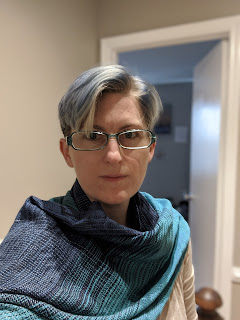After the twill project, I got ansty. I just really wanted to do a balanced 2/2 twill, but this is a thing that can't be done on a rigid heddle with two reeds.
I've been dreaming for years of building my own loom. It shouldn't be that hard. The only part I couldn't work out was the ratchet and pawl that keeps the beams from unwinding so the warp stays at a good tension. Most loom supply stores don't sell just that part by itself.
But, I realized, I did have a loom that had a ratchet and pawl . . . my 24-inch Ashford rigid heddle loom. And I had already built a simple stand for it. All I had to do was replace the heddle block with some kind of four-shaft system.
I decided to make a countermarche loom, on the grounds that 1) they work well for every kind of pattern and fiber, since they don't rely on the fiber stretching or the pattern being balanced, and 2) I understand how they work. The mechanism of jack looms confuses me a bit, and the pulleys involved in counterbalance looms seemed like they'd easily devolve into a tangly mess.
I started out by putting each shaft on a mechanism like a towel roller bar--a string going from the top heddle bar, over a top dowel, down to the bottom dowel, under that, and up to the bottom heddle bar. My thinking was that they'd move easily but stay put, the way roller towels do. I forgot that shafts are much heavier on the shaft end and therefore would tend to go down. But it still did mean they didn't fall straight the floor while I worked out the lamm system. Plus, it ensures the top and bottom heddle bars move together, whatever else happens.
Originally I meant to have only upper lams, on the grounds that the pedals could attach straight to the bottom bar of the shafts. But that meant too much tying things directly to the heddle bar, which I worried would confuse things and lead to them falling off a lot. So I put a row of lower lams as well.
Initially, I used wood 1x2s with hooks on them for the treadles. But this caused problems. First off, the cords kept slipping out of the hooks when there wasn't tension on them. And second, the weight of the treadles weighed down the shafts on the sides, pulling them askew. So I replaced those with PVC treadles, less aesthetic but lighter. As an added advantage, they were narrower so they pulled down the shafts closer to the middle of each one. Though I spaced them out some, to make room for my feet!
The heddles, I purchased. Could I have tied 200 string heddles? Sure. Do I want to? No. And I was afraid I wouldn't make them exact enough to work for my purposes. I also used, as a reed, one of my rigid heddles, hung on two nails when not in use. Eventually, I want to buy a proper reed, and make some kind of a beater for it.
My first project was a twill scarf of handpainted silk yarn. The sett was too wide, leading to a weft-faced result. That's the fault of the rigid heddle reed--I only have two, a 7.5 and a 15 dent, but because I can only use the slots, they're essentially 3.75 and 7.5 dent. Plus the fatness of the "eye" part makes the gap in the reed awfully narrow, which can stop the warp threads from sliding around as easily as they should.
But I'm happy with the scarf all the same. Many more projects to come!


















